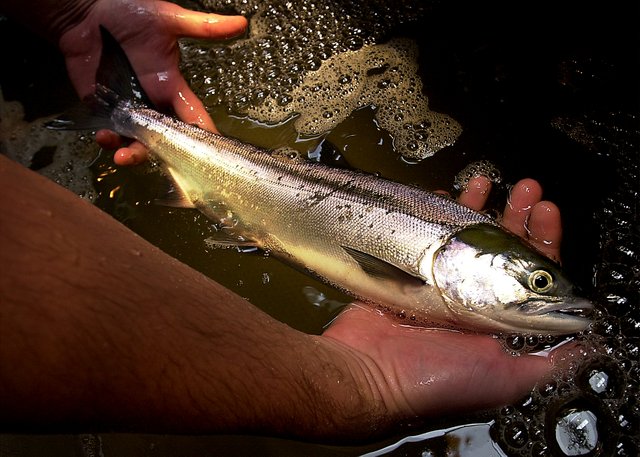forum
library
tutorial
contact

Columbia River Getting Huge Sockeye Run
by Allen ThomasThe Columbian, June 27, 2012
|
the film forum library tutorial contact |

|
Columbia River Getting Huge Sockeye Runby Allen ThomasThe Columbian, June 27, 2012 |
 Sockeye salmon -- great table fare, but not good biters on sport gear -- are streaming up the Columbia River in massive numbers and appear likely to be a record return this year.
Sockeye salmon -- great table fare, but not good biters on sport gear -- are streaming up the Columbia River in massive numbers and appear likely to be a record return this year.
Tuesday's count of 41,573 at Bonneville Dam was a record-high, topping Monday's count of 38,756. The old daily count record was 30,690 on June 24, 2010.
And, sockeye might be even more plentiful in the decades to come.
"It's an exciting success story of water management and ever-improving passage over the dams," said Steve Smith, a Canby, Ore., fisheries consultant who works extensively with the Colville tribe.
Cindy LeFleur of the Washington Department of Fish and Wildlife, chair of the Columbia River Technical Advisory Committee, said the panel of scientists determined on Monday the sockeye run is on track to be the forecasted record of 462,000.
The cumulative count through Tuesday is 289,493. The current mark is almost 388,000 in 2010.
Sockeye migrate through the lower Columbia in June and July, with the peak counts at Bonneville normally about July 1. They are an inland-origin fish, which needs rearing lakes in their natal watershed as part of their life cycle.
The predictions for this summer are for 28,800 sockeye to return to the Wenatchee River, 1,900 to the Snake River and a whopping 431,300 to the Okanogan River.
Smith said more spill and surface bypass systems at the Columbia River dams have helped sockeye, just as chinook are benefitting.
But the big improvement was initiated seven or eight years ago when the Canadians changed the streamflow management in the portion of the Okanogan River north of the international border.
Sockeye would spawn in the fall then water levels would drop later exposing the redds, Smith said.
The Canadians changed the water levels in the Okanogan River reservoirs, balancing the flows and keeping them high enough to protect the eggs in the gravel, he said.
"Two years ago, Canada estimated 8 million sockeye young coming out of Lake Osoyoos, the lower reservoir on the river," Smith said. "On average, it was 1 million, so a big increase."
There's much more of the Okanogan watershed in Canada that might some day be available to sockeye.
Smith said the second reservoir is Skaha Lake, where the fish ladder is blocked with logs. Farther upstream is Okanagan Lake, which is 83 miles long.
"If access was restored, an expert estimates the rearing capacity could be increased 20 times," he said.
The Canadians blocked off Skaha Lake to manage the reservoir for resident fish. Years ago, the Canadians got so few sockeye back through the American hydro system and harvest that their citizens gained more from resident fisheries.
"The harvest was all about the ocean and lower river," Smith said. "This is what happened when the end users did not get benefit."
But given the success in the Okanogan recently, the Canadians are looking at the historic habitat used by sockeye, he said.
Smith said there may be a fantastic fishery for sockeye at the mouth of the Okanogan River.
Some years, the Okanogan gets very warm and the thermal barrier keeps the fish in the pool behind Wells Dam until the rains start in late August or early September.
"It can be a tremendous sport fishery," Smith said.
The 2008-17 Columbia River fishery management plan limits the non-Indian harvest to 1 percent of the run, which is about 4,600 this year.
The gillnet fleet landed 373 sockeye during its eight hours of fishing on June 17-18.
Most of the sport catch comes downstream of Longview by anglers targeting on chinook or summer steelhead. Washington and Oregon estimate anglers kept 3,007 sockeye and released 339 in fishing between mid-May and Sunday.
learn more on topics covered in the film
see the video
read the script
learn the songs
discussion forum
